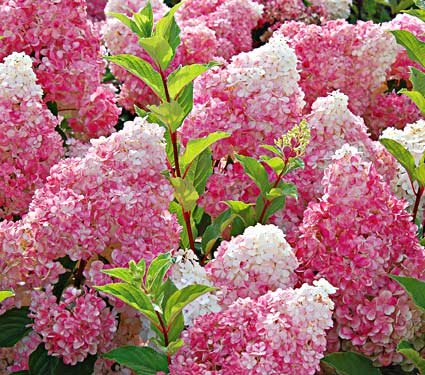

Well I fought the good fight and I won...lol. Yep I went about 10 rounds today with 2 very thorny, very deep rooted, very infuriating rose bushes... They were big, bad, and very unforgiving, as I yanked and pulled, and cut roots, for 10, 20, 30, oh maybe 45 minutes on each bush...omg. At one point I was yanking the plants out of the ground like I was pulling a whale from the ocean...the whale wasn't going down without a fight...Believe me...Geeee it was a struggle... But in the end perseverance and lots of patience won out...Those bad boys are up, and the spaces are ready to plant something different, hopefully something more permanent. I'm thinking strawberry vanilla hydrangeas..This variety of hydrangea loves the sun, and is very tolerant of heat. Also I'm thinking Little lime hydrangeas which have very interesting flowers and supposedly bloom all season...I also need something to give the landscape some height...Hmmmmm...Any thoughts....for a full to part shade area????

 Well I fought the good fight and I won...lol. Yep I went about 10 rounds today with 2 very thorny, very deep rooted, very infuriating rose bushes... They were big, bad, and very unforgiving, as I yanked and pulled, and cut roots, for 10, 20, 30, oh maybe 45 minutes on each bush...omg. At one point I was yanking the plants out of the ground like I was pulling a whale from the ocean...the whale wasn't going down without a fight...Believe me...Geeee it was a struggle... But in the end perseverance and lots of patience won out...Those bad boys are up, and the spaces are ready to plant something different, hopefully something more permanent. I'm thinking strawberry vanilla hydrangeas..This variety of hydrangea loves the sun, and is very tolerant of heat. Also I'm thinking Little lime hydrangeas which have very interesting flowers and supposedly bloom all season...I also need something to give the landscape some height...Hmmmmm...Any thoughts....for a full to part shade area????
Well I fought the good fight and I won...lol. Yep I went about 10 rounds today with 2 very thorny, very deep rooted, very infuriating rose bushes... They were big, bad, and very unforgiving, as I yanked and pulled, and cut roots, for 10, 20, 30, oh maybe 45 minutes on each bush...omg. At one point I was yanking the plants out of the ground like I was pulling a whale from the ocean...the whale wasn't going down without a fight...Believe me...Geeee it was a struggle... But in the end perseverance and lots of patience won out...Those bad boys are up, and the spaces are ready to plant something different, hopefully something more permanent. I'm thinking strawberry vanilla hydrangeas..This variety of hydrangea loves the sun, and is very tolerant of heat. Also I'm thinking Little lime hydrangeas which have very interesting flowers and supposedly bloom all season...I also need something to give the landscape some height...Hmmmmm...Any thoughts....for a full to part shade area????
And God said, “Behold, I have given you every plant yielding seed that is on the face of all the earth, and every tree with seed in its fruit. If it came forth than you shouldn't have killed it.
ReplyDeleteOld rose bushes regain productivity with the proper care.
Rose bushes often become unproductive with age. Over 150 species of roses (Rosa spp.) exist, with the first cultivation beginning about 5,000 years ago. Modern varieties of rose generally live up to 10 years, while older varieties are known to live to 50 or more years when given the best care. The longer a rose lives, the more attention it needs to produce new, healthy growth. A neglected old rose will need special treatment to revive and bloom.
Dip pruning shears and lopping shears in rubbing alcohol to clean them. Remove about half of the old, thick and barky canes, cutting the canes at the base. Reduce the amount of canes by up to two-thirds of the growth. Head younger canes up to half their height, making cuts 1/4 inch above an outward facing bus at a 45-degree angle. Thin out weak canes, suckers and any canes that cross each other.
Aerate the soil around the rose starting around 1 foot away from the base of the plant. Stick a picthfork into the ground and loosen the soil by moving it back and forth. Repeat over an area about 3 feet in diameter, spiraling away from the rose and taking care around the roots. This loosens compacted soil and allows the amendments to absorb quicker.
Broadcast 1 cup of 10-10-10 granular rose fertilizer and 1 cup of bonemeal starting about 6 inches from the base of the plant and spreading it to 18 inches in diameter. Work the lime or sulfur, bonemeal and fertilizer into the soil with a stiff rake, being careful not to damage shallow roots. The fertilizer and bonemeal replenish the nutrients the rose needs to produce new growth.
Spread a 3-inch layer of mulch in a 2-foot diameter around the rose starting 6 inches out from the base. Use wood chips, bark, shredded hardwood or any other mulch that decomposes. The mulch does a number of things to help an old rose rejuvenate, including adding nutrients and aerating the soil as it decomposes, preventing competing weed growth, and conserving moisture levels in the soil.
Give the rose supplemental water every week. Older roses need about 8 gallons of water per week. In dry, quick draining soil, water twice per week. If your soil drains more slowly, you usually can water only once per week. Fill a bucket with water and allow it to sit until it reaches approximately air temperature before watering the rose.